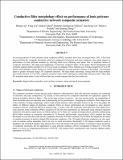Conductive Filler Morphology Effect on Performance of Ionic Polymer Conductive Network Composite Actuators
Author(s)
Liu, Sheng; Liu, Yang; Cebeci, Hulya Geyik; Guzman de Villoria, Roberto; Lin, Jun-Hong; Wardle, Brian L.; ... Show more Show less
DownloadLiu-2010-Conductive filler.pdf (5.153Mb)
PUBLISHER_POLICY
Publisher Policy
Article is made available in accordance with the publisher's policy and may be subject to US copyright law. Please refer to the publisher's site for terms of use.
Terms of use
Metadata
Show full item recordAbstract
Several generations of ionic polymer metal composite (IPMC) actuators have been developed since 1992. It has been discovered that the composite electrodes which are composed of electronic and ionic conductors, have great impact on performance of ionic polymer actuators by affecting strain level, efficiency and speed. One of important factors in composite electrodes is the shape and morphology of electronic conductor fillers. In this paper, RuO2 nanoparticles and vertically aligned carbon nanotube (Va-CNT) are used as conductor fillers. Making use of unique properties of Va-CNT forests with ultrahigh volume fraction in Nafion nanocomposite, an ionic polymer actuator is developed. Ion transport speed is greatly increased along CNT alignment direction. The high elastic anisotropy, arising from the high modulus and volume fraction of Va-CNTs, enhances actuation strain while reducing the undesirable direction strain. More than 8% actuation strain under 4 volts with less than one second response time has been achieved.
Date issued
2010-04Department
Massachusetts Institute of Technology. Department of Aeronautics and AstronauticsJournal
Proceedings of SPIE--the International Society for Optical Engineering; v. 7642
Publisher
SPIE
Citation
Liu, Sheng et al. “Conductive filler morphology effect on performance of ionic polymer conductive network composite actuators.” Electroactive Polymer Actuators and Devices (EAPAD) 2010. Ed. Yoseph Bar-Cohen. San Diego, CA, USA: SPIE, 2010. 764219-10. Web.
Version: Final published version
ISSN
0277-786X
Keywords
aligned carbon nanotubes, ionic polymer actuators, strain and speed, nanocomposite